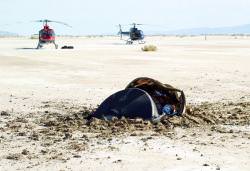As the parachute failed on re-entry, a man hanging out of a helicopter wielding a big hook didn’t have chance to grab the falling object. Instead, it entered the atmosphere and thudded into the crusty layer of sand in the Utah Desert. This isn’t some Monty Python sketch, it was the demise of the Genesis sample return probe as the descent mechanism failed to release its parachutes on September 8th 2004. Hope to analyze any of the pristine samples of the Sun’s atmosphere quickly dissipated as scientists realized the precious cargo was likely destroyed and contaminated. But now, with a bit of luck and a lot of patience, mission scientists have recovered some samples from the wreckage and hope most of the Genesis mission goals will be accomplished regardless…
Launched from Earth on August 8th 2001, the Genesis spacecraft was sent on its way to the Earth-Sun First Lagrangian (L1) point to collect solar wind particles in the aim of understanding our Sun and solar system development. All was going very smoothly for this Discovery-class NASA mission (consisting of a spacecraft and sample return probe piggybacking) and the probe collected solar wind particles from December 2001 to April 2004 by exposing an array of sample collectors.
Task accomplished, the spacecraft returned toward Earth and the sample return probe separated from the Genesis “bus”. The probe fell through the atmosphere to begin its parachute deployment. It should have deployed the parachute as sensors detected a sudden deceleration as the Earth’s atmosphere thickened. But due to a technical fault, this didn’t happen. The parachute should have allowed the probe to glide slowly through the atmosphere, and using a unique helicopter capture technique (guy with a hook hanging out of a helicopter swooping down to collect the probe mid-glide), there would be very little impact the probe would experience. The smaller the force of impact, the better the chance of retrieving the very delicate solar wind particles.
But to their horror, Genesis scientists could only watch as the 600lb sample return probe thudded into the Utah desert at 193 miles per hour.
Surprisingly, the probe wasn’t totally destroyed and much of the contents were protected on impact as the soft mud and sand of the desert lessened the blow. Also, the collector arrays allowed solar wind particles to be deeply embedded within the material, keeping them clear of any terrestrial material that may have contaminated the samples as the probe crashed. Still, the outlook looked bleak for any analysis of the samples the $264 million mission hoped to bring back in one piece.
Fortunately, the Genesis mission was lucky – there are enough samples left uncontaminated by terrestrial debris and these tiny solar particles are beginning to help scientists understand the particles existing in the ultimate clean room: interplanetary space. Not only that, these particles hold the key to the development of our solar system (hence the “Genesis” mission name) and provide clues to the development of stars, nebulae and planets in other systems.
“One would not normally characterise the Genesis mission as being lucky, but in this case we were.” – Kevin McKeegan, UCLA
Of particular interest will be the measurement of the primordial form of oxygen as it is emitted from the Sun in the solar wind. If we can measure the quantities of oxygen isotopes in the solar wind, we will have a starting point from which other oxygen isotopes are formed from. The Earth, Moon and meteorites have vastly differing quantities of oxygen-16, oxygen-17 and oxygen-18. Why this is the case is a mystery to scientists. Using the Genesis data as a foundation to this work will help us understand how the oxygen isotopes evolved so differently in different parts of the solar system.
Source: BBC


It is hard to imagine that anything so delicate could survive that violent an impact and remain uncontaminated.
Why has it taken three and a half years to find out there are some samples which have survived?
If you look at how the concentrator was contructed, you can imagine how three out of four targets survived the crash. SiC is a very hard material, so despite the crash, none of the contamination mixed into the sample.
It didn’t take 3-1/2 years to find out that some samples survived! It took 3-1/2 years to figure out how to make a measurement that had never been done before.